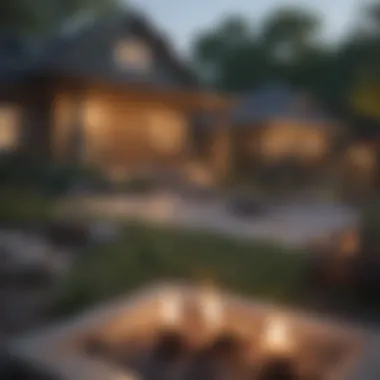Exploring Affordable Suburbs in Austin: A Comprehensive Guide


Intro
Austin, Texas, is a vibrant city with a rich culture, making it an attractive destination for homebuyers. However, the surge in real estate prices often pushes affordable options out of reach for many potential homeowners. This guide seeks to illuminate affordable suburbs in the Austin area, allowing homebuyers to explore neighborhoods that offer both value and unique community characteristics. By highlighting vital aspects such as architectural designs, local amenities, and cultural significance, this comprehensive analysis empowers readers to make informed decisions in the Austin housing market.
Feature Spotlight
Exceptional Architectural Designs
Each suburb in the Austin area can be characterized by its distinctive architectural styles. From mid-century modern homes to traditional Texan ranch-style properties, these neighborhoods offer a diverse tapestry of design choices. This diversity not only reflects the history of the area but also showcases the creativity of the local builders and architects.
For example, neighborhoods like Cedar Park and Round Rock feature an array of properties that merge modern aesthetics with functionality. Homebuyers often prefer these designs that offer an inviting atmosphere, tailored for both families and individuals alike. Additionally, some suburbs embrace eco-friendly designs, incorporating sustainable practices that appeal to environmentally conscious buyers.
Unique Decor Elements
Beyond just the structures themselves, the uniqueness continues into the decor elements evident throughout these suburbs. Local artisans contribute to the aesthetic appeal of neighborhoods through public art installations and beautifully landscaped parks. Westlake Hills is a perfect representation. Its art corridors and decorative public spaces foster a sense of community pride and visual interest.
Homeowners can enhance their individual properties with elements that reflect local culture. This might include partnering with local designers who harness the spirit of Austin, resulting in homes with bespoke finishes and decor. By understanding and embracing these unique decor styles, homeowners can not only accentuate their home but also feel connected to the broader community dynamics.
Location Highlights
Must-Visit Neighborhoods
When searching for affordability, certain neighborhoods must be prioritized. Areas like Manor and Pflugerville offer some of the most competitive housing prices while maintaining access to essential amenities. The charm of these suburbs lies in their blend of suburban tranquility with urban convenience, making them ideal for various homeowners.
- Manor is known for newer constructions, appealing to first-time homebuyers.
- Pflugerville boasts access to numerous parks and recreational facilities, attracting families who prioritize outdoor activities.
Cultural and Historical Significance
Many affordable suburbs of Austin are steeped in rich history. For instance, Leander is not just affordable but also showcases historic sites that connect residents to their past. The old towns and heritage sites provide valuable insights into the local culture, encouraging a community spirit. Access to such history enhances the living experience for residents, providing not just a home but a community rooted in shared experiences.
"Finding an affordable home in Austin is like discovering a hidden gem in a crowded marketplace. Each neighborhood holds potential, waiting to be explored."
Preamble to Affordable Housing in Austin
Affordable housing in Austin is a vital subject for anyone considering a move to this vibrant city. Given the rising cost of living and the rapid expansion of the tech industry, it is crucial to understand the landscape of affordable suburbs. These areas offer a practical solution for homebuyers seeking a balance between a desirable lifestyle and financial viability.
Housing affordability affects various aspects of urban living. It plays an essential role in shaping community dynamics, driving economic growth, and offering social stability. A well-informed approach to affordable housing can guide potential homeowners toward neighborhoods that suit their needs without compromising their budget.
The concept of affordability in housing is multifaceted, encompassing not just the price of homes but also overall living expenses, quality of schools, and access to amenities. Understanding these elements helps homebuyers make informed decisions. What is the trade-off between affordability and desirable features? What are the unique characteristics of the suburbs that maintain a blend of comfort, community, and accessibility? This guide aims to provide a comprehensive outlook on these issues.
The Real Estate Market Landscape
The real estate market landscape in Austin is evolving rapidly. Over the last decade, Austin has gained a reputation as a tech hub, attracting various industries and professionals. This influx has significantly influenced housing prices. As demand increases, so does competition for affordable housing options around the metropolitan area. As a result, new developments in suburbs are emerging to cater for the need for affordable living.
Moreover, the demographics of these suburbs are changing, with an increasing number of families, young professionals, and retirees seeking to relocate. Such shifts contribute to a more vibrant community. The suburban areas of Austin are offering a range of housing styles from modern apartments to single-family homes. This connectivity to urban life while retaining a suburban feel makes these neighborhoods attractive to many buyers.
Understanding Affordability
Understanding affordability goes beyond just the purchase price of a home. It includes a range of factors affecting a homeowner's budget. Monthly mortgage payments, insurance costs, property taxes, and maintenance expenses must all be considered.
To assess whether a suburb is truly affordable, one should look at:
- Median Home Prices: This gives an idea of how much residents typically pay for housing.
- Cost of Living: This includes the price of groceries, utilities, and education, which can significantly impact household budgets.
- Access to Employment: Suburbs located within reasonable commuting distances from job centers often offer better overall value.
- Quality of Life: A neighborhood with access to parks, schools, and essential amenities can enhance living standards.


By evaluating these aspects, potential homebuyers can identify suburbs that not only fit their financial capabilities but also fulfill their lifestyle preferences.
Key Factors Influencing Suburban Affordability
Understanding the key factors that determine suburban affordability is essential for those seeking to invest or relocate in Austin's burgeoning housing market. These factors can significantly impact availability, price, and the overall livability of neighborhoods. By analyzing these elements, homebuyers can make informed decisions that align with their desires and financial capabilities.
Economic Trends and Housing Prices
The local economy plays a critical role in shaping the housing market in Austin. Economic growth often correlates with increases in employment opportunities which can drive demand for housing. As more people flock to the area for work, competition for homes may elevate prices, impacting affordability.
Currently, Austin is experiencing a blend of job growth in technology, healthcare, and education. This growth attracts new residents but also places upward pressure on housing costs. In recent years, the median home prices in the suburbs have risen, reflecting a broader national trend. However, some suburbs maintain relatively lower price points compared to the city center, providing opportunities for savvy buyers.
Economic trends should also factor in interest rates. When mortgage rates rise, affordability decreases, and potential buyers may find themselves priced out of specific areas. Thus, understanding both current wages and economic indicators is crucial for forecasting housing trends.
Population Growth and Its Impact
Population dynamics are pivotal in determining the real estate landscape. Austin's rapid population growth fuels demand for housing, often outpacing supply. The influx of new residents, drawn by job opportunities and a desirable lifestyle, drives an increase in housing demand which, in turn, affects pricing.
Furthermore, suburban areas often see more significant pressure as families and individuals look for affordable options compared to urban centers. This can lead to an immediate impact on the availability of affordable homes. Increased demand often results in rising rents and home prices, making it essential for potential buyers to act quickly when they find a suitable property.
The continuous development of new housing complexes aims to address these challenges, but it might take time for supply to catch up with demand. Thus, understanding the demographic shifts and underlying trends can provide insights into where affordable housing might remain available.
Policies Affecting Real Estate Development
Government policies also substantially shape the real estate market and influence affordability in Austin's suburbs. Zoning laws, permitting processes, and development incentives can either facilitate or hinder housing growth. For instance, areas with more flexible zoning laws often see increased development of both residential and mixed-use properties, providing options for homebuyers.
Moreover, local initiatives that promote affordable housing construction can change the landscape significantly. Policies aiming at providing subsidies, tax breaks, or grants can encourage developers to create units within a more affordable range. Understanding these policies is critical not just for current market conditions but also for future planning.
It’s important to stay informed about local government proposals, as they can directly affect the availability of affordable housing. Keeping an ear to the ground about upcoming regulations can be a strategic advantage for homebuyers and investors alike.
Affordable housing is not just about lower prices; it’s also about accessible location, community services, and lifestyle quality.
In summary, the intersection of economic trends, population changes, and government policies defines affordability in Austin's suburbs. Homebuyers must consider these factors to navigate the ever-changing market effectively.
Prominent Affordable Suburbs in Austin
The suburban areas surrounding Austin are essential for anyone looking to balance affordability while enjoying the amenities that come with urban living. These suburbs present attractive options for homebuyers seeking lower prices compared to the often steep costs within the city limits. In addition to price considerations, many of these neighborhoods offer unique features, such as access to parks, good schools, and a strong sense of community.
Choosing the right suburb can significantly impact daily life, job commutes, and recreational opportunities. Thus, it is vital to delve into the specifics of each suburb, including their characteristics, residential options, and lifestyle amenities.
Round Rock: A Growing Hub
Round Rock has gained popularity for its rapid expansion and appealing amenities. With a robust job market and quality educational institutions, the area attracts families and young professionals alike. The presence of the Round Rock Donuts and various tech companies boosts its local economy.
The housing market here presents viable options, with prices generally lower than Austin's. Parks such as Old Settlers Park provide recreational spaces, while events like the Round Rock Express games add a vibrant community element. Accessibility to major highways also enhances connectivity.
Pflugerville: Family-Friendly Environment
Pflugerville distinguishes itself as an inviting suburb for families. It has a range of housing options that cater to different budgets, and its schools consistently receive high ratings. The community is known for its family-centered events and rich array of parks, such as Lake Pflugerville, which offers water activities and walking trails.
This suburb fosters a sense of community with neighborhood organizations and frequent gatherings. The experiences available here create a supportive network for families and a welcoming environment.
Cedar Park: Blending Nature and Community


Cedar Park stands out with its balance of nature and suburban living. The area features ample green spaces and nature trails, making it appealing for those who appreciate the outdoors. The suburban layout supports a variety of community events that encourage neighborly interaction.
Cedar Park offers diverse shopping options, from local boutiques to national retailers. Educational institutions in Cedar Park are well regarded, drawing families looking for quality schooling.
Leander: Affordable and Scenic
Leander is becoming increasingly attractive for those seeking affordable housing without sacrificing quality of life. It is characterized by scenic landscapes and tranquil surroundings, making it a popular choice for nature lovers. The housing prices here are often more reasonable than neighboring areas, making it an appealing choice for first-time buyers.
The area is served by good schools and community resources, making it a convenient place for families. Leander's upcoming developments aim to enhance the local economy and community services.
South Austin: A Diverse Choice
South Austin presents a unique blend of diversity and culture. Known for its eclectic vibe and artistic community, this area offers an alternative to more traditional suburban experiences. Housing prices may vary, but options remain competitive compared to central Austin.
Residents enjoy a vibrant arts scene, with local galleries and community events enriching cultural life. The area's parks provide ample outdoor activities, while dining and shopping reflect Austin's diverse culinary and retail landscape.
Lifestyle and Amenities in Austin's Suburbs
The lifestyle and amenities available in the suburbs of Austin play a significant role in attracting homebuyers. These suburbs offer not just affordable housing but also a quality of life that blends convenience and community. The collective elements found in these regions create environments conducive for families, professionals, and retirees alike. When exploring the suburbs, it is essential to consider the access to recreational areas, the vibrancy of cultural events, and the quality of educational institutions.
Access to Parks and Recreation
Parks and recreational facilities contribute immensely to the overall lifestyle in Austin's suburbs. These spaces serve as essential gathering points for communities. They offer a natural respite from daily life, enhancing mental well-being and physical health for residents. Enjoying outdoor activities in Brushy Creek Regional Park or participating in community sports leagues can significantly strengthen community ties. Access to hiking trails, playgrounds, and picnic areas provides families with options for leisure and interaction. Many suburbs, such as Round Rock and Pflugerville, have made strides in ensuring that park facilities are well-maintained and accessible, catering to residents' diverse needs.
Cultural and Community Events
Cultural events create a vibrant community atmosphere in Austin's suburbs. These events range from local fairs to seasonal festivals. Each event fosters a sense of belonging and celebrates the unique characteristics of each suburb. For instance, Downtown Round Rock hosts the Quesoff every year, capturing the interest of local food enthusiasts. Engaging in these events can provide interactions that enhance one's sense of community. Such activities often spotlight local artists and businesses, bolstering the economy while enriching residents' social lives.
Educational Institutions and Facilities
Quality educational institutions are a primary consideration for families looking at affordable suburbs. The presence of strong public and private schools, as well as community colleges, can be pivotal in choosing where to live. Suburbs like Cedar Park and Leander are well-regarded for their educational offerings. Access to well-structured school districts enhances property values and attracts homebuyers seeking quality education for their children. Moreover, proximity to higher education facilities can entice a wider demographic, including young professionals and students, contributing to a more dynamic community.
"The availability and quality of parks, cultural events, and schools in Austin's suburbs are crucial factors for many families considering relocation."
In summary, the lifestyle and amenities in Austin's suburbs are a vital aspect of the holistic experience of living in these areas. A blend of leisure options, community events, and educational opportunities not only elevates the quality of life but also ensures a well-rounded living experience for residents.
Transportation and Connectivity
Transportation and connectivity are essential elements that define the quality of life in affordable suburbs of Austin. In a sprawling metropolitan area, access to various modes of transport can significantly influence housing choices. Suburbs with effective transportation networks can enhance living conditions by facilitating commutes to work, school, and recreational activities.
Establishing robust transportation options can also lead to increased property values over time. Moreover, connectivity helps reduce reliance on personal vehicles, offering residents the ability to engage with surrounding communities more easily. In addition, public transit availability is critical for families, young professionals, and retirees who may prefer not to drive.
In this section, we explore public transportation options and examine average commuting times to Downtown Austin, both vital to understanding the overall appeal of suburban living.
Public Transportation Options
Public transportation options in Austin's suburbs have expanded in recent years. The Capital Metro system is a major player in providing bus services that link various suburbs to the city. Its routes cover significant areas, ensuring that residents can access schools, shopping, and job centers without requiring a car.
- Bus Services: Capital Metro operates several bus routes that connect suburbs like Round Rock, Pflugerville, and Cedar Park with Austin's downtown area. Buses typically run from early morning until late evening, allowing flexibility for commuters.
- MetroRail: The MetroRail Red Line offers an alternative for residents living closer to its stations. This commuter train runs from Leander to downtown Austin, providing a convenient transportation option that alleviates traffic congestion.
- Future Developments: Plans for expanded transit projects are underway, potentially creating more routes and options. This could enhance connectivity further, making suburbs even more appealing for potential new residents.
Commuting Times to Downtown Austin
Commuting times from suburbs to Downtown Austin are an important aspect of suburban living. A reasonable commute can make a significant difference in work-life balance and overall satisfaction.


Average commuting times vary by suburb. For instance:
- Round Rock: Approximately 25 minutes by car, making it one of the most accessible suburbs.
- Pflugerville: Around 30 minutes, slightly longer but still manageable for most commuters.
- Cedar Park: On average, it takes about 35 minutes driving downtown.
- Leander: Commuters can expect around a 40-minute drive, depending on traffic.
- South Austin: Depending on the time of day, commutes can generally take between 15-25 minutes, as these areas are somewhat closer to downtown.
These times can fluctuate due to peak traffic periods, but overall, the suburbs of Austin maintain relatively swift access to the city center. With improving public transport options and strategic road developments, the landscape for commuting looks promising. Thus, understanding and evaluating transportation and connectivity is essential for homebuyers looking for affordable yet practical living spaces in Austin.
Real Estate Trends in Affordable Suburbs
Real estate trends in affordable suburbs encompass a myriad of factors that shape the housing market. These trends are crucial for understanding how communities evolve and for potential homeowners to assess where to invest.
Recently, a notable shift in buyer preferences has emerged in the Austin suburbs. Many individuals and families are turning away from traditional urban living due to rising housing costs and seeking out areas that offer better value. This change highlights the significance of location, economic stability, and lifestyle choices in real estate decisions.
Emerging Neighborhoods to Watch
In the realm of affordable suburbs, some neighborhoods are gaining attention for their promising characteristics and potential for growth. Areas like Hutto and Manor are becoming magnets for home buyers who appreciate a more relaxed pace of life while still being accessible to the vibrant culture of Austin.
- Hutto: This suburb has experienced rapid development, led by new shopping centers and parks. Its affordability is appealing to first-time homebuyers.
- Manor: Known for its expanding infrastructure, Manor offers proximity to Austin while maintaining competitive prices.
These neighborhoods often showcase innovative housing developments, which cater to modern lifestyles while remaining budget-friendly. Buyers should monitor these areas close, as economic factors may lead to sudden appreciation in home values.
The Impact of Development Projects
Development projects greatly influence real estate trends in affordable suburbs. New commercial centers, educational institutions, and recreational facilities enhance the desirability of these areas, often resulting in increased demand for homes.
For instance, projects like the Texas Innovation Center in North Austin have spurred growth in nearby suburbs, encouraging families to consider locations that were previously overlooked. Furthermore, infrastructure enhancements, such as upgrades to roadways and public transport, change accessibility and market dynamics.
- Gentrification Risks: As development projects occur, there is also a risk of gentrification affecting existing residents. Homebuyers should be wary of these changes, ensuring their investment aligns with personal values and community sustainability.
- Market Trends: Developers are noticing the trend toward mixed-use spaces, where living, working, and recreational amenities coalesce. This trend is instrumental in shaping modern suburbia and offers significant value to prospective homeowners.
"Understanding these trends is vital for making informed real estate decisions in Austin's suburbs."
In summary, real estate trends provide a lens to examine the future landscape of affordable suburbs. Buyers must look beyond the immediate price and consider the broader implications of economic and infrastructural developments.
Epilogue: Making Informed Choices
Making informed choices when selecting a suburb in the Austin area is crucial for potential homeowners and those considering relocation. Understanding the unique characteristics of each suburb goes beyond just affordability. It involves evaluating personal needs, lifestyle preferences, and future goals. This article has provided a comprehensive overview of the affordable suburbs around Austin and highlighted factors essential to the decision-making process.
The importance of evaluating one’s preferences cannot be understated. Factors such as proximity to work, school quality, and community amenities play a significant role in how comfortable and fulfilling life can be in a suburban setting. Thus, taking the time to assess what matters most can lead to a satisfying choice that fits well within an individual’s or a family’s lifestyle.
Moreover, the affordability aspect is only one part of the equation. Understanding local market trends, community dynamics, and evaluating future growth potential are essential. Each of these elements contributes to the overall desirability of a suburb.
Key Points for Consideration:
- Personal needs and lifestyle preferences
- Quality of schools and educational facilities
- Access to recreational activities and cultural amenities
- Community satisfaction and safety statistics
By synthesizing the information from various sections of this article, readers can develop a clearer picture of which suburban neighborhoods might be appropriate for them. It encourages a thorough analysis that combines financial considerations with personal aspirations.
Evaluating Personal Needs and Preferences
When it comes to selecting a suburb in Austin, one size does not fit all. Each individual or family has distinct preferences and requirements that will guide their choice. Personal needs might include factors like commute times, school districts, and local health care facilities. Having clarity around these needs can significantly streamline the search process.
For instance, professionals commuting to downtown Austin should consider suburbs with efficient transportation options. In contrast, families with children may prioritize neighborhoods known for their excellent schools and parks. Local amenities like grocery stores, fitness centers, and entertainment options further enrich life in the suburbs and should not be overlooked.
Future Prospects for Austin's Suburbs
As Austin continues to grow, the suburbs surrounding it also undergo transformation. Future development projects, infrastructure improvements, and population growth all play a role in shaping these areas.
A suburb that is affordable today might see rapid price increases as demand grows. Keeping an eye on future development plans is essential. For instance, investment in public transport can enhance a suburb's appeal, making it more attractive for potential homebuyers in the next few years.
In summary, the journey of choosing an affordable suburb in Austin should not be taken lightly. By aligning personal needs with the potential of each neighborhood, individuals and families can make choices that not only fit their budget but also enhance their quality of life.







